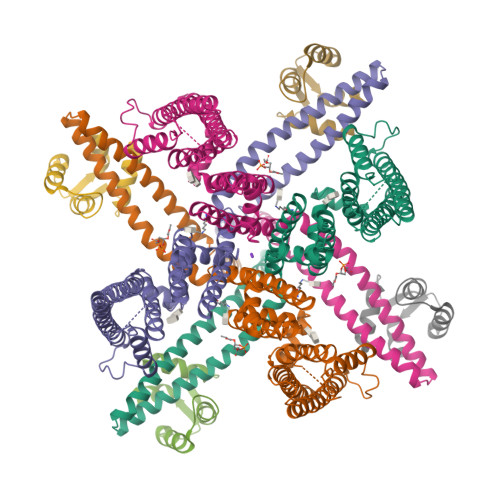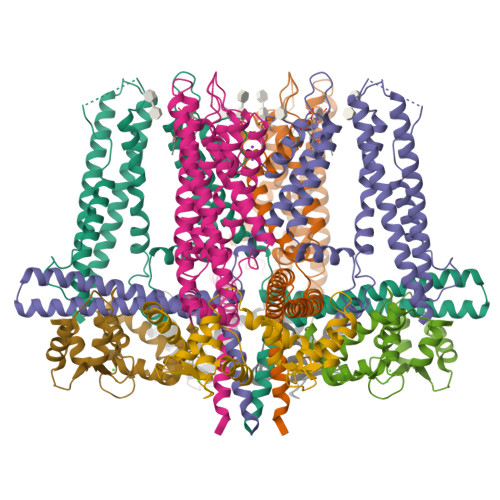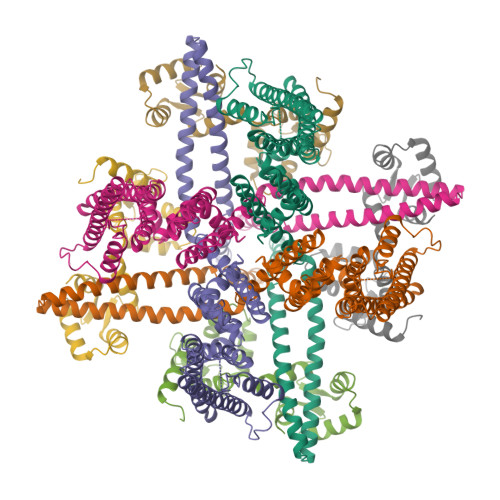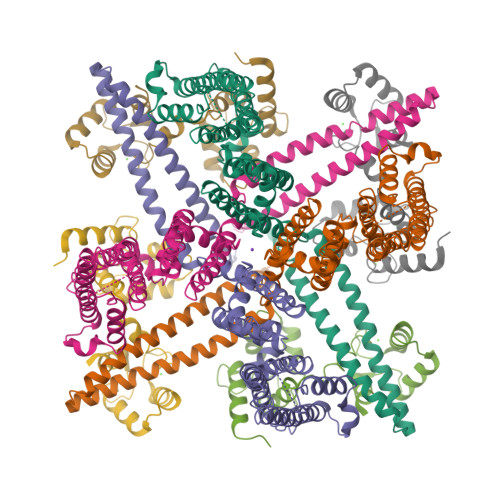GtoPdb is requesting financial support from commercial users. Please see our sustainability page for more information.
KCa3.1
 Target has curated data in GtoImmuPdb
Target has curated data in GtoImmuPdb
Target id: 384
Nomenclature: KCa3.1
Family: Calcium- and sodium-activated potassium channels (KCa, KNa)
Contents:
- Gene and Protein Information
- Previous and Unofficial Names
- Database Links
- Selected 3D Structures
- Associated Proteins
- Functional Characteristics
- Ion Selectivity and Conductance
- Voltage Dependence
- Activators
- Gating Inhibitors
- Channel Blockers
- Immunopharmacology Comments
- Immuno Cell Type Associations
- Tissue Distribution
- Functional Assays
- Physiological Functions
- Phenotypes, Alleles and Disease Models
- Clinically-Relevant Mutations and Pathophysiology
- Gene Expression and Pathophysiology
- References
- Contributors
- How to cite this page
Gene and Protein Information  |
|||||||
| Species | TM | P Loops | AA | Chromosomal Location | Gene Symbol | Gene Name | Reference |
| Human | 6 | 1 | 427 | 19q13.31 | KCNN4 | potassium calcium-activated channel subfamily N member 4 | 22-23,29,31,42 |
| Mouse | 6 | 1 | 425 | 7 A3 | Kcnn4 | potassium intermediate/small conductance calcium-activated channel, subfamily N, member 4 | 71 |
| Rat | 6 | 1 | 425 | 1q21 | Kcnn4 | potassium calcium-activated channel subfamily N member 4 | 73 |
Database Links  |
|
| Alphafold | O15554 (Hs), O89109 (Mm), Q9QYW1 (Rn) |
| ChEMBL Target | CHEMBL4305 (Hs) |
| DrugBank Target | O15554 (Hs) |
| Ensembl Gene | ENSG00000104783 (Hs), ENSMUSG00000054342 (Mm), ENSRNOG00000019440 (Rn) |
| Entrez Gene | 3783 (Hs), 16534 (Mm), 65206 (Rn) |
| Human Protein Atlas | ENSG00000104783 (Hs) |
| KEGG Gene | hsa:3783 (Hs), mmu:16534 (Mm), rno:65206 (Rn) |
| OMIM | 602754 (Hs) |
| Pharos | O15554 (Hs) |
| RefSeq Nucleotide | NM_002250 (Hs), NM_008433 (Mm), NM_023021 (Rn) |
| RefSeq Protein | NP_002241 (Hs), NP_032459 (Mm), NP_075410 (Rn) |
| UniProtKB | O15554 (Hs), O89109 (Mm), Q9QYW1 (Rn) |
| Wikipedia | KCNN4 (Hs) |
Selected 3D Structures  |
|||||||||||||

|
|
||||||||||||

|
|
||||||||||||

|
|
||||||||||||

|
|
||||||||||||
Associated Proteins  |
||||||||||||||||||||||
|
|
|
||||||||||||||||||||
Functional Characteristics  |
|
| IKCa; KCa3.1 may form heteromers with KCa2.1 [27]. | |
Ion Selectivity and Conductance  |
||||||
|
| Voltage Dependence Comments |
| KCa3.1 is voltage independent. |
Download all structure-activity data for this target as a CSV file 
| Activators | |||||||||||||||||||||||||||||||||||||||||||||||||||||||||||||||||||||||||||||||||||||||||||||||||||||||||||||||||||||||||||||||||||||||||||||||||||||||||||||||||||||||||||||||||||||||||||||||||||||||||||||||||||||||||||||||||||||||||||||||||||||||||||||||||||||||||||||||||||||||||||||||||||||||||||||||||||||||||||||||||||||||||||||||||||||||||||||||||||||||||||||||||||||||||||||
| Key to terms and symbols | View all chemical structures | Click column headers to sort | |||||||||||||||||||||||||||||||||||||||||||||||||||||||||||||||||||||||||||||||||||||||||||||||||||||||||||||||||||||||||||||||||||||||||||||||||||||||||||||||||||||||||||||||||||||||||||||||||||||||||||||||||||||||||||||||||||||||||||||||||||||||||||||||||||||||||||||||||||||||||||||||||||||||||||||||||||||||||||||||||||||||||||||||||||||||||||||||||||||||||||||||||||||||||||
|
|||||||||||||||||||||||||||||||||||||||||||||||||||||||||||||||||||||||||||||||||||||||||||||||||||||||||||||||||||||||||||||||||||||||||||||||||||||||||||||||||||||||||||||||||||||||||||||||||||||||||||||||||||||||||||||||||||||||||||||||||||||||||||||||||||||||||||||||||||||||||||||||||||||||||||||||||||||||||||||||||||||||||||||||||||||||||||||||||||||||||||||||||||||||||||||
| Activator Comments | |||||||||||||||||||||||||||||||||||||||||||||||||||||||||||||||||||||||||||||||||||||||||||||||||||||||||||||||||||||||||||||||||||||||||||||||||||||||||||||||||||||||||||||||||||||||||||||||||||||||||||||||||||||||||||||||||||||||||||||||||||||||||||||||||||||||||||||||||||||||||||||||||||||||||||||||||||||||||||||||||||||||||||||||||||||||||||||||||||||||||||||||||||||||||||||
| No species differences described; NS309, DCEBIO, riluzole and EBIO increase the Ca2+ sensitivity of both KCa3.1 and KCa2 channels; see [77-78] for a recent extensive review of KCa3.1 and KCa2 channel pharmacology. | |||||||||||||||||||||||||||||||||||||||||||||||||||||||||||||||||||||||||||||||||||||||||||||||||||||||||||||||||||||||||||||||||||||||||||||||||||||||||||||||||||||||||||||||||||||||||||||||||||||||||||||||||||||||||||||||||||||||||||||||||||||||||||||||||||||||||||||||||||||||||||||||||||||||||||||||||||||||||||||||||||||||||||||||||||||||||||||||||||||||||||||||||||||||||||||
| Gating Inhibitor Comments | ||
| [1,3-phenylenebis(methylene) bis(3-fluoro-4-hydroxybenzoate) (RA-2) is a negative gating modulator that inhibits KCa3.1 with an IC50 of 17 nM and all three KCa2 channels with similar potency. It right-shifts the Ca2+ activation curve [46]. The inhibitory gating modulator of KCa2 channels NS8593 does not block KCa3.1 [64]. |
| Channel Blockers | |||||||||||||||||||||||||||||||||||||||||||||||||||||||||||||||||||||||||||||||||||||||||||||||||||||||||||||||||||||||||||||||||||||||||||||||||||||||||||||||||||||||||||||||||||||||||||||||||||||||||||||||||||||||||||||||||||||||||||||||||||||||||||||||||||||||||||||||||||||||||||||||||||||||||||||||||||||||||||||||||||||||||||||||||||||||||||||||||||||||||||||||||||||||||||||||||||||||||||||||||||||||||||||||||||||||||||||||||||||||||
| Key to terms and symbols | View all chemical structures | Click column headers to sort | |||||||||||||||||||||||||||||||||||||||||||||||||||||||||||||||||||||||||||||||||||||||||||||||||||||||||||||||||||||||||||||||||||||||||||||||||||||||||||||||||||||||||||||||||||||||||||||||||||||||||||||||||||||||||||||||||||||||||||||||||||||||||||||||||||||||||||||||||||||||||||||||||||||||||||||||||||||||||||||||||||||||||||||||||||||||||||||||||||||||||||||||||||||||||||||||||||||||||||||||||||||||||||||||||||||||||||||||||||||||
|
|||||||||||||||||||||||||||||||||||||||||||||||||||||||||||||||||||||||||||||||||||||||||||||||||||||||||||||||||||||||||||||||||||||||||||||||||||||||||||||||||||||||||||||||||||||||||||||||||||||||||||||||||||||||||||||||||||||||||||||||||||||||||||||||||||||||||||||||||||||||||||||||||||||||||||||||||||||||||||||||||||||||||||||||||||||||||||||||||||||||||||||||||||||||||||||||||||||||||||||||||||||||||||||||||||||||||||||||||||||||||
| Channel Blocker Comments | |||||||||||||||||||||||||||||||||||||||||||||||||||||||||||||||||||||||||||||||||||||||||||||||||||||||||||||||||||||||||||||||||||||||||||||||||||||||||||||||||||||||||||||||||||||||||||||||||||||||||||||||||||||||||||||||||||||||||||||||||||||||||||||||||||||||||||||||||||||||||||||||||||||||||||||||||||||||||||||||||||||||||||||||||||||||||||||||||||||||||||||||||||||||||||||||||||||||||||||||||||||||||||||||||||||||||||||||||||||||||
| Many more blockers have been characterised; see [77-78] for an extensive review of the pharmacology. | |||||||||||||||||||||||||||||||||||||||||||||||||||||||||||||||||||||||||||||||||||||||||||||||||||||||||||||||||||||||||||||||||||||||||||||||||||||||||||||||||||||||||||||||||||||||||||||||||||||||||||||||||||||||||||||||||||||||||||||||||||||||||||||||||||||||||||||||||||||||||||||||||||||||||||||||||||||||||||||||||||||||||||||||||||||||||||||||||||||||||||||||||||||||||||||||||||||||||||||||||||||||||||||||||||||||||||||||||||||||||
| Immunopharmacology Comments |
| KCa3.1 and KV1.3 are the predominant potassium channels involved in regulating the hyperpolarized (negative) membrane potential which is critical for immune cell activation [12,18,43]. KCa3.1 is voltage-independent and is activated by Ca2+ binding to the calmodulin that is always present at the channel's C terminus. In activated T cells, KCa3.1 and KV1.3 localise to the immunological synapse, where interactions with regulatory kinases occurs. In addition to functions in cell cycle progression and cellular proliferation, KCa3.1 channels play an important immunoregulatory role, including participation in pathologic mechanisms that are associated with the inflammatory and proliferative cascades that characterise autoimmune diseases such as rheumatoid arthritis [20,54]. Notably KCa3.1 knockout mice are resistant to experimental collagen‐induced (i.e. autoimmune) arthritis [54]. KCa3.1 is involved in lymphocyte activation, and in the proliferation and migration of T cells, B cells, mast cells, macrophages and fibroblasts. As an inflammation-relevant drug target [75], KCa3.1 modulators are being investigated for potential in the treatment of asthma and fibroproliferative disorders, and for immunosuppressant efficacy [72]. |
| Cell Type Associations | ||||||
|
||||||
|
||||||
|
Tissue Distribution 
|
||||||||
|
||||||||
|
||||||||
|
||||||||
|
||||||||
|
||||||||
|
Functional Assays 
|
||||||||||
|
||||||||||
|
||||||||||
|
||||||||||
|
||||||||||
|
Physiological Functions 
|
||||||||
|
||||||||
|
||||||||
|
||||||||
|
||||||||
|
||||||||
|
||||||||
|
Phenotypes, Alleles and Disease Models 
|
Mouse data from MGI | ||||||||||||||||||||||||||||||||||||||||||||||||||||||||||||||||||||||||||||||||||||||||||||||||||||||||||||||||||||||||||||||||||||
|
|||||||||||||||||||||||||||||||||||||||||||||||||||||||||||||||||||||||||||||||||||||||||||||||||||||||||||||||||||||||||||||||||||||
Clinically-Relevant Mutations and Pathophysiology 
|
||||||||||||||||||||||||
|
||||||||||||||||||||||||
|
||||||||||||||||||||||||
|
||||||||||||||||||||||||
|
||||||||||||||||||||||||
|
||||||||||||||||||||||||
Gene Expression and Pathophysiology 
|
||||||||||||
|
References
1. Andolfo I, Russo R, Manna F, Shmukler BE, Gambale A, Vitiello G, De Rosa G, Brugnara C, Alper SL, Snyder LM et al.. (2015) Novel Gardos channel mutations linked to dehydrated hereditary stomatocytosis (xerocytosis). Am J Hematol, 90 (10): 921-6. [PMID:26178367]
2. Ataga KI, Orringer EP, Styles L, Vichinsky EP, Swerdlow P, Davis GA, Desimone PA, Stocker JW. (2006) Dose-escalation study of ICA-17043 in patients with sickle cell disease. Pharmacotherapy, 26 (11): 1557-64. [PMID:17064199]
3. Ayabe T, Wulff H, Darmoul D, Cahalan MD, Chandy KG, Ouellette AJ. (2002) Modulation of mouse Paneth cell alpha-defensin secretion by mIKCa1, a Ca2+-activated, intermediate conductance potassium channel. J Biol Chem, 277 (5): 3793-800. [PMID:11724775]
4. Begenisich T, Nakamoto T, Ovitt CE, Nehrke K, Brugnara C, Alper SL, Melvin JE. (2004) Physiological roles of the intermediate conductance, Ca2+-activated potassium channel Kcnn4. J Biol Chem, 279 (46): 47681-7. [PMID:15347667]
5. Brugnara C, de Franceschi L, Alper SL. (1993) Inhibition of Ca(2+)-dependent K+ transport and cell dehydration in sickle erythrocytes by clotrimazole and other imidazole derivatives. J Clin Invest, 92 (1): 520-6. [PMID:8326017]
6. Brugnara C, Gee B, Armsby CC, Kurth S, Sakamoto M, Rifai N, Alper SL, Platt OS. (1996) Therapy with oral clotrimazole induces inhibition of the Gardos channel and reduction of erythrocyte dehydration in patients with sickle cell disease. J Clin Invest, 97 (5): 1227-34. [PMID:8636434]
7. Bychkov R, Burnham MP, Richards GR, Edwards G, Weston AH, Félétou M, Vanhoutte PM. (2002) Characterization of a charybdotoxin-sensitive intermediate conductance Ca2+-activated K+ channel in porcine coronary endothelium: relevance to EDHF. Br J Pharmacol, 137 (8): 1346-54. [PMID:12466245]
8. Castle NA, London DO, Creech C, Fajloun Z, Stocker JW, Sabatier JM. (2003) Maurotoxin: a potent inhibitor of intermediate conductance Ca2+-activated potassium channels. Mol Pharmacol, 63 (2): 409-18. [PMID:12527813]
9. Chandy KG, Wulff H, Beeton C, Pennington M, Gutman GA, Cahalan MD. (2004) K+ channels as targets for specific immunomodulation. Trends Pharmacol Sci, 25 (5): 280-9. [PMID:15120495]
10. Chung I, Zelivyanskaya M, Gendelman HE. (2002) Mononuclear phagocyte biophysiology influences brain transendothelial and tissue migration: implication for HIV-1-associated dementia. J Neuroimmunol, 122 (1-2): 40-54. [PMID:11777542]
11. Coleman N, Brown BM, Oliván-Viguera A, Singh V, Olmstead MM, Valero MS, Köhler R, Wulff H. (2014) New positive Ca2+-activated K+ channel gating modulators with selectivity for KCa3.1. Mol Pharmacol, 86 (3): 342-57. [PMID:24958817]
12. DeCoursey TE, Chandy KG, Gupta S, Cahalan MD. (1985) Voltage-dependent ion channels in T-lymphocytes. J Neuroimmunol, 10 (1): 71-95. [PMID:2414315]
13. Devor DC, Singh AK, Lambert LC, DeLuca A, Frizzell RA, Bridges RJ. (1999) Bicarbonate and chloride secretion in Calu-3 human airway epithelial cells. J Gen Physiol, 113 (5): 743-60. [PMID:10228185]
14. Di L, Srivastava S, Zhdanova O, Sun Y, Li Z, Skolnik EY. (2010) Nucleoside diphosphate kinase B knock-out mice have impaired activation of the K+ channel KCa3.1, resulting in defective T cell activation. J Biol Chem, 285 (50): 38765-71. [PMID:20884616]
15. Eichler I, Wibawa J, Grgic I, Knorr A, Brakemeier S, Pries AR, Hoyer J, Köhler R. (2003) Selective blockade of endothelial Ca2+-activated small- and intermediate-conductance K+-channels suppresses EDHF-mediated vasodilation. Br J Pharmacol, 138 (4): 594-601. [PMID:12598413]
16. Ellory JC, Culliford SJ, Smith PA, Wolowyk MW, Knaus EE. (1994) Specific inhibition of Ca-activated K channels in red cells by selected dihydropyridine derivatives. Br J Pharmacol, 111 (3): 903-5. [PMID:8019767]
17. Fanger CM, Ghanshani S, Logsdon NJ, Rauer H, Kalman K, Zhou J, Beckingham K, Chandy KG, Cahalan MD, Aiyar J. (1999) Calmodulin mediates calcium-dependent activation of the intermediate conductance KCa channel, IKCa1. J Biol Chem, 274 (9): 5746-54. [PMID:10026195]
18. Feske S, Wulff H, Skolnik EY. (2015) Ion channels in innate and adaptive immunity. Annu Rev Immunol, 33: 291-353. [PMID:25861976]
19. Fioretti B, Castigli E, Calzuola I, Harper AA, Franciolini F, Catacuzzeno L. (2004) NPPB block of the intermediate-conductance Ca2+-activated K+ channel. Eur J Pharmacol, 497 (1): 1-6. [PMID:15321728]
20. Friebel K, Schönherr R, Kinne RW, Kunisch E. (2015) Functional role of the KCa3.1 potassium channel in synovial fibroblasts from rheumatoid arthritis patients. J Cell Physiol, 230 (7): 1677-88. [PMID:25545021]
21. GARDOS G. (1958) The function of calcium in the potassium permeability of human erythrocytes. Biochim Biophys Acta, 30 (3): 653-4. [PMID:13618284]
22. Ghanshani S, Coleman M, Gustavsson P, Wu AC, Gargus JJ, Gutman GA, Dahl N, Mohrenweiser H, Chandy KG. (1998) Human calcium-activated potassium channel gene KCNN4 maps to chromosome 19q13.2 in the region deleted in diamond-blackfan anemia. Genomics, 51 (1): 160-1. [PMID:9693050]
23. Ghanshani S, Wulff H, Miller MJ, Rohm H, Neben A, Gutman GA, Cahalan MD, Chandy KG. (2000) Up-regulation of the IKCa1 potassium channel during T-cell activation. Molecular mechanism and functional consequences. J Biol Chem, 275 (47): 37137-49. [PMID:10961988]
24. Glogowska E, Lezon-Geyda K, Maksimova Y, Schulz VP, Gallagher PG. (2015) Mutations in the Gardos channel (KCNN4) are associated with hereditary xerocytosis. Blood, 126 (11): 1281-4. [PMID:26198474]
25. Grgic I, Eichler I, Heinau P, Si H, Brakemeier S, Hoyer J, Köhler R. (2005) Selective blockade of the intermediate-conductance Ca2+-activated K+ channel suppresses proliferation of microvascular and macrovascular endothelial cells and angiogenesis in vivo. Arterioscler Thromb Vasc Biol, 25 (4): 704-9. [PMID:15662023]
26. Grissmer S, Nguyen AN, Cahalan MD. (1993) Calcium-activated potassium channels in resting and activated human T lymphocytes. Expression levels, calcium dependence, ion selectivity, and pharmacology. J Gen Physiol, 102 (4): 601-30. [PMID:7505804]
27. Higham J, Sahu G, Wazen RM, Colarusso P, Gregorie A, Harvey BSJ, Goudswaard L, Varley G, Sheppard DN, Turner RW et al.. (2019) Preferred Formation of Heteromeric Channels between Coexpressed SK1 and IKCa Channel Subunits Provides a Unique Pharmacological Profile of Ca2+-Activated Potassium Channels. Mol Pharmacol, 96 (1): 115-126. [PMID:31048549]
28. Ishihara T, Ikigai K, Kuriwaki I, Hisamichi H, Takeshita N, Takezawa R. (2014) Benzothiophene compound. Patent number: WO2014196644A1. Assignee: Astellas Pharma Inc.. Priority date: 16/06/2014. Publication date: 11/12/2014.
29. Ishii TM, Silvia C, Hirschberg B, Bond CT, Adelman JP, Maylie J. (1997) A human intermediate conductance calcium-activated potassium channel. Proc Natl Acad Sci USA, 94 (21): 11651-6. [PMID:9326665]
30. Jensen BS, Strobaek D, Christophersen P, Jorgensen TD, Hansen C, Silahtaroglu A, Olesen SP, Ahring PK. (1998) Characterization of the cloned human intermediate-conductance Ca2+-activated K+ channel. Am J Physiol, 275 (3): C848-56. [PMID:9730970]
31. Joiner WJ, Wang LY, Tang MD, Kaczmarek LK. (1997) hSK4, a member of a novel subfamily of calcium-activated potassium channels. Proc Natl Acad Sci USA, 94 (20): 11013-8. [PMID:9380751]
32. Jäger H, Dreker T, Buck A, Giehl K, Gress T, Grissmer S. (2004) Blockage of intermediate-conductance Ca2+-activated K+ channels inhibit human pancreatic cancer cell growth in vitro. Mol Pharmacol, 65 (3): 630-8. [PMID:14978241]
33. Kaushal V, Koeberle PD, Wang Y, Schlichter LC. (2007) The Ca2+-activated K+ channel KCNN4/KCa3.1 contributes to microglia activation and nitric oxide-dependent neurodegeneration. J Neurosci, 27 (1): 234-44. [PMID:17202491]
34. Khanna R, Chang MC, Joiner WJ, Kaczmarek LK, Schlichter LC. (1999) hSK4/hIK1, a calmodulin-binding KCa channel in human T lymphocytes. Roles in proliferation and volume regulation. J Biol Chem, 274 (21): 14838-49. [PMID:10329683]
35. Khanna R, Roy L, Zhu X, Schlichter LC. (2001) K+ channels and the microglial respiratory burst. Am J Physiol, Cell Physiol, 280 (4): C796-806. [PMID:11245596]
36. King B, Rizwan AP, Asmara H, Heath NC, Engbers JD, Dykstra S, Bartoletti TM, Hameed S, Zamponi GW, Turner RW. (2015) IKCa channels are a critical determinant of the slow AHP in CA1 pyramidal neurons. Cell Rep, 11 (2): 175-82. [PMID:25865881]
37. Köhler R, Brakemeier S, Kühn M, Behrens C, Real R, Degenhardt C, Orzechowski HD, Pries AR, Paul M, Hoyer J. (2001) Impaired hyperpolarization in regenerated endothelium after balloon catheter injury. Circ Res, 89 (2): 174-9. [PMID:11463725]
38. Köhler R, Eichler I, Schönfelder H, Grgic I, Heinau P, Si H, Hoyer J. (2005) Impaired EDHF-mediated vasodilation and function of endothelial Ca-activated K channels in uremic rats. Kidney Int, 67 (6): 2280-7. [PMID:15882269]
39. Köhler R, Hoyer J. (2007) The endothelium-derived hyperpolarizing factor: insights from genetic animal models. Kidney Int, 72 (2): 145-50. [PMID:17457372]
40. Köhler R, Wulff H, Eichler I, Kneifel M, Neumann D, Knorr A, Grgic I, Kämpfe D, Si H, Wibawa J, Real R, Borner K, Brakemeier S, Orzechowski HD, Reusch HP, Paul M, Chandy KG, Hoyer J. (2003) Blockade of the intermediate-conductance calcium-activated potassium channel as a new therapeutic strategy for restenosis. Circulation, 108 (9): 1119-25. [PMID:12939222]
41. Lee CH, MacKinnon R. (2018) Activation mechanism of a human SK-calmodulin channel complex elucidated by cryo-EM structures. Science, 360 (6388): 508-513. [PMID:29724949]
42. Logsdon NJ, Kang J, Togo JA, Christian EP, Aiyar J. (1997) A novel gene, hKCa4, encodes the calcium-activated potassium channel in human T lymphocytes. J Biol Chem, 272 (52): 32723-6. [PMID:9407042]
43. Matteson DR, Deutsch C. (1984) K channels in T lymphocytes: a patch clamp study using monoclonal antibody adhesion. Nature, 307 (5950): 468-71. [PMID:6320008]
44. Mauler F, Hinz V, Horváth E, Schuhmacher J, Hofmann HA, Wirtz S, Hahn MG, Urbahns K. (2004) Selective intermediate-/small-conductance calcium-activated potassium channel (KCNN4) blockers are potent and effective therapeutics in experimental brain oedema and traumatic brain injury caused by acute subdural haematoma. Eur J Neurosci, 20 (7): 1761-8. [PMID:15379997]
45. Neylon CB, Lang RJ, Fu Y, Bobik A, Reinhart PH. (1999) Molecular cloning and characterization of the intermediate-conductance Ca(2+)-activated K(+) channel in vascular smooth muscle: relationship between K(Ca) channel diversity and smooth muscle cell function. Circ Res, 85 (9): e33-43. [PMID:10532960]
46. Oliván-Viguera A, Valero MS, Coleman N, Brown BM, Laría C, Murillo MD, Gálvez JA, Díaz-de-Villegas MD, Wulff H, Badorrey R et al.. (2015) A novel pan-negative-gating modulator of KCa2/3 channels, fluoro-di-benzoate, RA-2, inhibits endothelium-derived hyperpolarization-type relaxation in coronary artery and produces bradycardia in vivo. Mol Pharmacol, 87 (2): 338-48. [PMID:25468883]
47. Ong ST, Nam YW, Nasburg JA, Ramanishka A, Ng XR, Zhuang Z, Goay SSM, Nguyen HM, Singh L, Singh V et al.. (2025) Design and structural basis of selective 1,4-dihydropyridine inhibitors of the calcium-activated potassium channel KCa3.1. Proc Natl Acad Sci U S A, 122 (18): e2425494122. [PMID:40294255]
48. Ouadid-Ahidouch H, Roudbaraki M, Delcourt P, Ahidouch A, Joury N, Prevarskaya N. (2004) Functional and molecular identification of intermediate-conductance Ca(2+)-activated K(+) channels in breast cancer cells: association with cell cycle progression. Am J Physiol, Cell Physiol, 287 (1): C125-34. [PMID:14985237]
49. Parihar AS, Coghlan MJ, Gopalakrishnan M, Shieh CC. (2003) Effects of intermediate-conductance Ca2+-activated K+ channel modulators on human prostate cancer cell proliferation. Eur J Pharmacol, 471 (3): 157-64. [PMID:12826234]
50. Pedarzani P, Mosbacher J, Rivard A, Cingolani LA, Oliver D, Stocker M, Adelman JP, Fakler B. (2001) Control of electrical activity in central neurons by modulating the gating of small conductance Ca2+-activated K+ channels. J Biol Chem, 276 (13): 9762-9. [PMID:11134030]
51. Peña TL, Chen SH, Konieczny SF, Rane SG. (2000) Ras/MEK/ERK Up-regulation of the fibroblast KCa channel FIK is a common mechanism for basic fibroblast growth factor and transforming growth factor-beta suppression of myogenesis. J Biol Chem, 275 (18): 13677-82. [PMID:10788486]
52. Rapetti-Mauss R, Lacoste C, Picard V, Guitton C, Lombard E, Loosveld M, Nivaggioni V, Dasilva N, Salgado D, Desvignes JP et al.. (2015) A mutation in the Gardos channel is associated with hereditary xerocytosis. Blood, 126 (11): 1273-80. [PMID:26148990]
53. Rauer H, Lanigan MD, Pennington MW, Aiyar J, Ghanshani S, Cahalan MD, Norton RS, Chandy KG. (2000) Structure-guided transformation of charybdotoxin yields an analog that selectively targets Ca(2+)-activated over voltage-gated K(+) channels. J Biol Chem, 275 (2): 1201-8. [PMID:10625664]
54. Raychaudhuri SK, Wulff H, Raychaudhuri SP. (2016) KCa3.1(-/-) Mice Do Not Develop CIA: Regulatory Role for KCa3.1 in Autoimmune Arthritis. J Cell Physiol, 231 (11): 2313-4. [PMID:26910182]
55. Reich EP, Cui L, Yang L, Pugliese-Sivo C, Golovko A, Petro M, Vassileva G, Chu I, Nomeir AA, Zhang LK et al.. (2005) Blocking ion channel KCNN4 alleviates the symptoms of experimental autoimmune encephalomyelitis in mice. Eur J Immunol, 35 (4): 1027-36. [PMID:15770697]
56. Rufo PA, Merlin D, Riegler M, Ferguson-Maltzman MH, Dickinson BL, Brugnara C, Alper SL, Lencer WI. (1997) The antifungal antibiotic, clotrimazole, inhibits chloride secretion by human intestinal T84 cells via blockade of distinct basolateral K+ conductances. Demonstration of efficacy in intact rabbit colon and in an in vivo mouse model of cholera. J Clin Invest, 100 (12): 3111-20. [PMID:9399958]
57. Sankaranarayanan A, Raman G, Busch C, Schultz T, Zimin PI, Hoyer J, Köhler R, Wulff H. (2009) Naphtho[1,2-d]thiazol-2-ylamine (SKA-31), a new activator of KCa2 and KCa3.1 potassium channels, potentiates the endothelium-derived hyperpolarizing factor response and lowers blood pressure. Mol Pharmacol, 75 (2): 281-95. [PMID:18955585]
58. Schilling T, Stock C, Schwab A, Eder C. (2004) Functional importance of Ca2+-activated K+ channels for lysophosphatidic acid-induced microglial migration. Eur J Neurosci, 19 (6): 1469-74. [PMID:15066143]
59. Si H, Heyken WT, Wölfle SE, Tysiac M, Schubert R, Grgic I, Vilianovich L, Giebing G, Maier T, Gross V et al.. (2006) Impaired endothelium-derived hyperpolarizing factor-mediated dilations and increased blood pressure in mice deficient of the intermediate-conductance Ca2+-activated K+ channel. Circ Res, 99 (5): 537-44. [PMID:16873714]
60. Singh S, Syme CA, Singh AK, Devor DC, Bridges RJ. (2001) Benzimidazolone activators of chloride secretion: potential therapeutics for cystic fibrosis and chronic obstructive pulmonary disease. J Pharmacol Exp Ther, 296 (2): 600-11. [PMID:11160649]
61. Srivastava S, Li Z, Ko K, Choudhury P, Albaqumi M, Johnson AK, Yan Y, Backer JM, Unutmaz D, Coetzee WA et al.. (2006) Histidine phosphorylation of the potassium channel KCa3.1 by nucleoside diphosphate kinase B is required for activation of KCa3.1 and CD4 T cells. Mol Cell, 24 (5): 665-75. [PMID:17157250]
62. Srivastava S, Zhdanova O, Di L, Li Z, Albaqumi M, Wulff H, Skolnik EY. (2008) Protein histidine phosphatase 1 negatively regulates CD4 T cells by inhibiting the K+ channel KCa3.1. Proc Natl Acad Sci USA, 105 (38): 14442-6. [PMID:18796614]
63. Stocker JW, De Franceschi L, McNaughton-Smith GA, Corrocher R, Beuzard Y, Brugnara C. (2003) ICA-17043, a novel Gardos channel blocker, prevents sickled red blood cell dehydration in vitro and in vivo in SAD mice. Blood, 101 (6): 2412-8. [PMID:12433690]
64. Strøbaek D, Hougaard C, Johansen TH, Sørensen US, Nielsen EØ, Nielsen KS, Taylor RD, Pedarzani P, Christophersen P. (2006) Inhibitory gating modulation of small conductance Ca2+-activated K+ channels by the synthetic compound (R)-N-(benzimidazol-2-yl)-1,2,3,4-tetrahydro-1-naphtylamine (NS8593) reduces afterhyperpolarizing current in hippocampal CA1 neurons. Mol Pharmacol, 70 (5): 1771-82. [PMID:16926279]
65. Strøbaek D, Teuber L, Jørgensen TD, Ahring PK, Kjaer K, Hansen RS, Olesen SP, Christophersen P, Skaaning-Jensen B. (2004) Activation of human IK and SK Ca2+ -activated K+ channels by NS309 (6,7-dichloro-1H-indole-2,3-dione 3-oxime). Biochim Biophys Acta, 1665 (1-2): 1-5. [PMID:15471565]
66. Strøbæk D, Brown DT, Jenkins DP, Chen YJ, Coleman N, Ando Y, Chiu P, Jørgensen S, Demnitz J, Wulff H et al.. (2013) NS6180, a new K(Ca) 3.1 channel inhibitor prevents T-cell activation and inflammation in a rat model of inflammatory bowel disease. Br J Pharmacol, 168 (2): 432-44. [PMID:22891655]
67. Syme CA, Gerlach AC, Singh AK, Devor DC. (2000) Pharmacological activation of cloned intermediate- and small-conductance Ca(2+)-activated K(+) channels. Am J Physiol, Cell Physiol, 278 (3): C570-81. [PMID:10712246]
68. Tharp DL, Wamhoff BR, Turk JR, Bowles DK. (2006) Upregulation of intermediate-conductance Ca2+-activated K+ channel (IKCa1) mediates phenotypic modulation of coronary smooth muscle. Am J Physiol Heart Circ Physiol, 291 (5): H2493-503. [PMID:16798818]
69. Urbahns K, Goldmann S, Krüger J, Horváth E, Schuhmacher J, Grosser R, Hinz V, Mauler F. (2005) IKCa-channel blockers. Part 2: discovery of cyclohexadienes. Bioorg Med Chem Lett, 15 (2): 401-4. [PMID:15603962]
70. Vaeth M, Feske S. (2018) Ion channelopathies of the immune system. Curr Opin Immunol, 52: 39-50. [PMID:29635109]
71. Vandorpe DH, Shmukler BE, Jiang L, Lim B, Maylie J, Adelman JP, de Franceschi L, Cappellini MD, Brugnara C, Alper SL. (1998) cDNA cloning and functional characterization of the mouse Ca2+-gated K+ channel, mIK1. Roles in regulatory volume decrease and erythroid differentiation. J Biol Chem, 273 (34): 21542-53. [PMID:9705284]
72. Wang J, Xiang M. (2013) Targeting potassium channels Kv1.3 and KC a 3.1: routes to selective immunomodulators in autoimmune disorder treatment?. Pharmacotherapy, 33 (5): 515-28. DOI: 10.1002/phar.1236 [PMID:23649812]
73. Warth R, Hamm K, Bleich M, Kunzelmann K, von Hahn T, Schreiber R, Ullrich E, Mengel M, Trautmann N, Kindle P et al.. (1999) Molecular and functional characterization of the small Ca(2+)-regulated K+ channel (rSK4) of colonic crypts. Pflugers Arch, 438 (4): 437-44. [PMID:10519135]
74. Weatherall KL, Goodchild SJ, Jane DE, Marrion NV. (2010) Small conductance calcium-activated potassium channels: from structure to function. Prog Neurobiol, 91 (3): 242-55. [PMID:20359520]
75. Wulff H, Castle NA. (2010) Therapeutic potential of KCa3.1 blockers: an overview of recent advances, and promising trends. Expert Rev Clin Pharmacol, 3 (3): 385–396. DOI: 10.1586/ecp.10.11
76. Wulff H, Knaus HG, Pennington M, Chandy KG. (2004) K+ channel expression during B cell differentiation: implications for immunomodulation and autoimmunity. J Immunol, 173 (2): 776-86. [PMID:15240664]
77. Wulff H, Kolski-Andreaco A, Sankaranarayanan A, Sabatier JM, Shakkottai V. (2007) Modulators of small- and intermediate-conductance calcium-activated potassium channels and their therapeutic indications. Curr Med Chem, 14 (13): 1437-57. [PMID:17584055]
78. Wulff H, Köhler R. (2013) Endothelial small-conductance and intermediate-conductance KCa channels: an update on their pharmacology and usefulness as cardiovascular targets. J Cardiovasc Pharmacol, 61 (2): 102-12. [PMID:23107876]
79. Wulff H, Miller MJ, Hansel W, Grissmer S, Cahalan MD, Chandy KG. (2000) Design of a potent and selective inhibitor of the intermediate-conductance Ca2+-activated K+ channel, IKCa1: a potential immunosuppressant. Proc Natl Acad Sci USA, 97 (14): 8151-6. [PMID:10884437]











